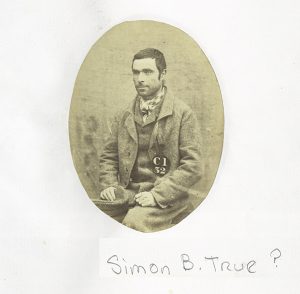KINDRED LINES: Prison photographs
Published in Features, Issue 4 (July/August 2016), Volume 24By Fiona Fitzsimons
Irish prisons were some of the first to make a photographic record of inmates before they were legally required to do so under the Habitual Criminals Act of 1869.In Ireland the earliest known prisoner photographs were taken in August 1857 in Mountjoy Jail. Other Irish prisons followed suit: Londonderry in 1865, Enniskillen in 1866 and Belfast in 1868.There are references in written material to Kilmainham Jail photographing inmates from the 1860s onwards but,with one exception, I have not come across any images surviving before 1881.

Above: ‘Simon B. True’—actually Simon Byrne, aged 36, born in Killeshin, Co. Laois,a three-time felon for larceny. (NYC Public Library)
Initially, prisoners’ photos were used to identify repeat offenders. After 1865, however, rapidly evolving international politics, in particular the end of the American Civil War, raised the prospect of further political unrest in Ireland, as experienced Irish-American officers involvedthemselves in Fenian activity. On 17 February 1866 the Habeas Corpus Suspension Act (HCSA)was passed, allowing for detention without trial of any person suspected of conspiracy. Many of those subsequently detained were not convicts, and any photographs taken by the prison authorities at this time were for the purposes of surveillance.What are known as the ‘Fenian photographs’ survive in two main collections. The larger, of 600 photographs taken between 1867 and 1872, is held in the National Archives of Ireland. A ‘Form K’ is attached to most of these photographs, to provide a description of the prisoner. Information recorded includes the particulars for arrest or conviction, the detainee’s physical description, age, literacy, religion, marital status, occupation and place of birth and residence.
A second, smaller collection of Fenian photographs, ‘The convicted and untried political prisoners in Mountjoy’, compiled in 1866, is now held in the NYC Public Library digital collections on-line. This album contains 86 portraits (4in.x3in.), mounted four to a page. Given the political imperative behind these photos, all prisoners are identified by name. Interestingly, 31% of these prisonersare recorded as having served in the Union or Confederate armies.Despite the endorsement on the title-page, examination of the on-line prison registers clearly shows that many of these prisoners were actually held in Kilmainham and elsewhere.
The Fenian photographs can be used in conjunction with other records relating to Fenianism, in particular the HCSA Abstracts and the prison registers. So, in this instance, the use ofgenealogical methodology enables a more in-depth study of the development of this radical nationalist movement.
Fiona Fitzsimons is a director of Eneclann, a Trinity campus company, and of findmypast Ireland.
FURTHER READING
Irish Prison Records, www.findmypast.com.
Thomas A. Larcom Photographs Collection, NYC Library,http://digitalcollections.nypl.org/collections/thomas-a-larcom-photographs-collection-1857-1866-mountjoy-prison#/?tab=navigation.
















